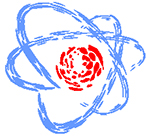Speaker
Mr
Daniyar Janseitov
(BLTP)
Description
Study of elastic and inelastic interaction of α-particles and nuclei is one of the main sources of information on the properties of basic and low-lying excited states of atomic nuclei. These processes proceeding at α-particle collisions with energies of a few tens MeV, provides to take valuable information about the structure of specific nuclear states. The objective measurement of the radii of the nuclei in unbound states has attracted a lot of attention in the last decade due to the hypothesis of the possible existence of α-particle condensation in alpha final nuclei [1].
The most probable candidate having the structure of α-particle condensate is still considered a known Hoyle state of 7.65 MeV (0+2) in the 12C nucleus. In the context of α-particle hypothesis, the level of 7.65 MeV in the nucleus 12C is the simplest example of α-particle condensate state and plays an important role in the testing of this problem. In the work [2], it is proposed that similar Hoyle state can be detected in some neighboring nuclei, such as excited state 8.86 MeV (1/2-) in the nucleus 13C.
Besides analogue Hoyle state, nucleus 13C is interesting by the fact that in the spectrum of different structures may coexist, for example, halo structure. The discovery of the neutron halo has become one of the most exciting discoveries in nuclear physics, made at the end of the last century. So far neutron halo was observed almost exclusively in the ground states of some radioactive nuclei. But the halo phenomenon may be detected at stable nuclei. In particular, in the work [3], it was assumed that the first excited state of 3.09 (1/2-) of nucleus 13C may have a structure of halo with increased radius.
Primary author
Mr
Daniyar Janseitov
(BLTP)

